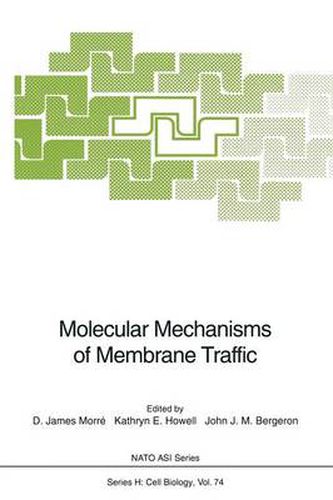Readings Newsletter
Become a Readings Member to make your shopping experience even easier.
Sign in or sign up for free!
You’re not far away from qualifying for FREE standard shipping within Australia
You’ve qualified for FREE standard shipping within Australia
The cart is loading…






This title is printed to order. This book may have been self-published. If so, we cannot guarantee the quality of the content. In the main most books will have gone through the editing process however some may not. We therefore suggest that you be aware of this before ordering this book. If in doubt check either the author or publisher’s details as we are unable to accept any returns unless they are faulty. Please contact us if you have any questions.
The study of membrane traffic in reconstituted cell-free systems has generated an unprecedented amount of new information on the biochemistry, molecular biology and genetics of membrane-based molecular events that underly normal and abnormal cellular function. Many of the individual steps have now been isolated and dissected in simple systems that permit detailed molecular analyses of transport mechanisms and their regulation. Reconstituted events of intercompartment transport include inter-membrane recognition, and controlled membrane fusion-fission reactions. Among the many advances is the growi ng awareness of a remarkabl e evolutionary conservation of many of the components involved in the many steps of membrane traffic, this realization has accelerated greatly the pace of progress in the field. This book provides a collection of participant contributions from the 1992 Summer Research Conference, Mol ecul ar Mechani sms of Membrane Traffi c,
jointly sponsored with NATO by the American Society of Cell Biology. The conference was held May 9-13, at the Airlie Conference Center in the Virginia countryside, near Warrenton. The conference was attended by 158 scientists. A unique feature was the high proportion of young scientists among the participants. Approximately 65% were students, postdoctoral fe 11 ows and young investigators. Each attendee contri buted to the conference with either a pl atform or poster presentation.
$9.00 standard shipping within Australia
FREE standard shipping within Australia for orders over $100.00
Express & International shipping calculated at checkout
Stock availability can be subject to change without notice. We recommend calling the shop or contacting our online team to check availability of low stock items. Please see our Shopping Online page for more details.
This title is printed to order. This book may have been self-published. If so, we cannot guarantee the quality of the content. In the main most books will have gone through the editing process however some may not. We therefore suggest that you be aware of this before ordering this book. If in doubt check either the author or publisher’s details as we are unable to accept any returns unless they are faulty. Please contact us if you have any questions.
The study of membrane traffic in reconstituted cell-free systems has generated an unprecedented amount of new information on the biochemistry, molecular biology and genetics of membrane-based molecular events that underly normal and abnormal cellular function. Many of the individual steps have now been isolated and dissected in simple systems that permit detailed molecular analyses of transport mechanisms and their regulation. Reconstituted events of intercompartment transport include inter-membrane recognition, and controlled membrane fusion-fission reactions. Among the many advances is the growi ng awareness of a remarkabl e evolutionary conservation of many of the components involved in the many steps of membrane traffic, this realization has accelerated greatly the pace of progress in the field. This book provides a collection of participant contributions from the 1992 Summer Research Conference, Mol ecul ar Mechani sms of Membrane Traffi c,
jointly sponsored with NATO by the American Society of Cell Biology. The conference was held May 9-13, at the Airlie Conference Center in the Virginia countryside, near Warrenton. The conference was attended by 158 scientists. A unique feature was the high proportion of young scientists among the participants. Approximately 65% were students, postdoctoral fe 11 ows and young investigators. Each attendee contri buted to the conference with either a pl atform or poster presentation.